






| Alan McNeil programmed TERSE, which is short for either "Terse Efficient Recursive Stack Engine" or "Terse Efficient Reentrant Stack Engine." This programming langauge was used at Dave Nutting Associates to program arcade games such as The Adventures of Robby Roto!, GORF and other games from the late 1970s and early 1980s. The TERSE language is based on FORTH. |
 |
Caltech Forth Manual (Excerpt). Chapter 2.7 - The Editor. Pages 28-34. From the collection of Jamie Fenton (BitSavers.org). The following text is from page 28 of this excerpt from the manual: FORTH has the capability of accepting its input from block storage. Such stored input commands are the normal means for "compiling" the standard FORTH system as well as application programs. The FORTH user may put FORTH commands, or any text material, into block storage by means of the FORTH editor. In the Caltech versions of FORTH, the editor is run as an "application program"; i.e. it must be loaded explicitly before use. The constant EDIT is defined as the address of the block that contains the editor; thus the command EDIT LOAD is sufficient to obtain the editor. The integer BLK is used to specify the FORTH block to be edited; thus to edit block 35, we type 35 BLK =. A FORTH block is conventionally defined to have a fixed format with 16 lines each of 64 characters. The 64th character of a line immediately precedes the first character of the next line. |
(Martin Ewing)_tn.jpg) |
Caltech Forth Manual. By Martin Ewing. 1983. From the preface of this book: Forth is a computer language and programming style that produces efficient programs and allows programmers to work very productively. At the same time, it is unorthodox, resistant to standardization, and difficult to describe. In a profession (and hobby) filled with individualists, Forth almost encourages personal and non-standard computing. With all its peculiarities and despite its uneven acceptance, Forth has grown from a specialized laboratory minicomputer system in the early 1970s to a widely popular language for both mini and microcomputers. Contemporary implementations range from the smallest 8—bit machines to 32-bit superminicomputers and' even some mainframe systems. Forth systems have found significant application in commercial markets, but their peak acceptance (in numbers, at least.) has been in the personal computer world. This book addresses two needs. First, it provides a motivation and description for the basic Forth vocabulary, as embodied in the Forth-79 standard. The treatment is concise and directed toward readers with some familiarity with computing, but it should be accessible to newcomers with general mathematical background. The second purpose of this work is to satisfy the curiosity and needs of programmers who have developed experience in Forth but who seek a more complete understanding of the internal structure of Forth. With this material, the Forth programmer should be able to adapt his system to new requirements, or to recode it for difference processors. The FORTH manual was downloaded form the website of Martin Ewing:
|
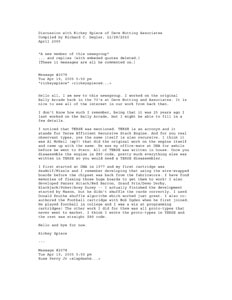
|
Discussion with Rickey Spiece of Dave Nutting Associates. Compiled by Richard C. Degler, 12/28/2010. April 2005. Rickey Speice "worked on the original Bally Arcade back in the 70's at Dave Nutting and Associates." This is a compilation of eleven postings to the Bally Alley Discussion group. |
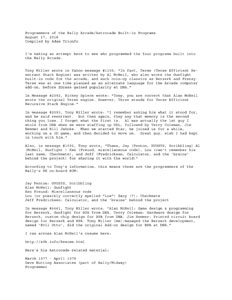
|
Programmers of the Bally Arcade/Astrocade Built-in Programs. Compiled by Adam Trionfo. August 17, 2016. This is an attempt to credit those people who programmed the four programs built into the Bally Arcade/Astrocade. These programs include: Calculator (Jeff Fredricksen), Checkmate (Lou, or possibly correctly spelled "Low," Harp), Gunfight (Alan McNeil), Scribbling (Jay Fenton), and miscellaneous code (Ken Freund). |
 |
TERSE 78 Standard Glossary. By Unknown. From the collection of Jamie Fenton (BitSavers.org). This is a description of the vocabularies. The words are presented in ASCII order- The first line of each entry shows a symbolic description of the action of the word: Symbols indicating which parameters are to be placed on the stack before executing the word, 3 dashes ( --- ) indicating execution, then any parameters left on the stack by the word. In this notation, the top of the stack is to the right. If the place of the word in the input string is not completely obvious, it is shown explicitly. If no dashes are shown the word does not affect the stack. Symbols are used as follows: |
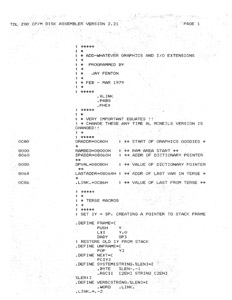 |
TERSE - Add-Whatever Graphics and I/O Extensions. By Jay Fenton. February/March 1979. From the collection of Jamie Fenton (BitSavers.org). This is 57 pages of Z80 assembly language code. I'm not sure how this relates to the TERSE language. Some quotes from the code: "Very important equates! Change these any time Al McNeil's version is changed!" "TERSE Macros." If you know what this code does when run, then please let me know and I'll provide details here. |
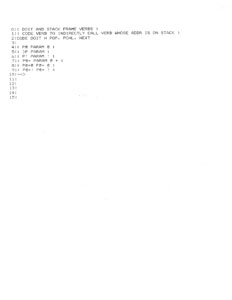 |
TERSE Code - "Indirectly Call Verb." By (probably) Jay Fenton. 15 pages of TERSE Program Code. From the collection of Jamie Fenton (BitSavers.org). From the TERSE language comments, "Code verb to indirectly call verb whose addr is on stack." |
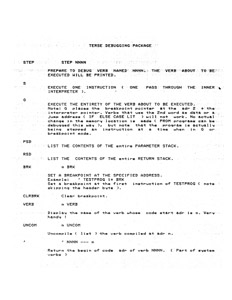 |
TERSE Debugger Package. From the collection of Jamie Fenton (BitSavers.org). This is a two-page list of the commands required to use the TERSE interactive debugger. |
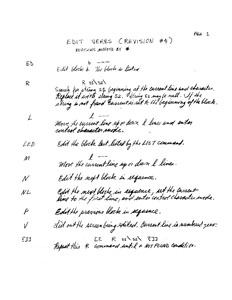 |
TERSE - Edit Verbs (Revision #4). Handwritten Notes. 198x. By Unknown. From the collection of Jamie Fenton (BitSavers.org). Four pages of short notes on how to use the editor to edit TERSE files, including a set of Edit Control Characters. |
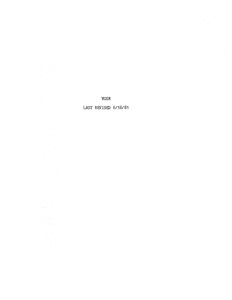 |
TERSE - VGER. June 18, 1981. From the collection of Jamie Fenton (BitSavers.org). This manual is 33 pages long. I'm not sure what VGER is an aberration for, but this 33-page document seems to describe how to use TERSE with macros that are in (perhaps?) a header file of some sort. The following information is from the table of contents (called the Index) in the document: Section 1:TRANSITIONS TIMER FLAG LIMITS DESTINATION INTERCEPT USERS INTERRUPT HOOK A TO B CALCULATION GO & WAIT Section 2: COORDINATES RECTANGULAR COORDINATE SYSTEM POLAR COORDINATE SYSTEM Section 3: WRITING PATTERNS ANIMATION TYPES WRITE OPTIONS STRING POSTING Section 4: UTILITIES USER VERBS SYSTEM HELPER VERBS USER SUBROUTINES QUEUES VECTOR RETURN STACK ERROR MESSAGES INTERRUPTS Section 5: CONSTANTS VECTOR CONSTANTS PORT CONSTANTS Section 6: EXAMPLE TASK EXAMPLE |
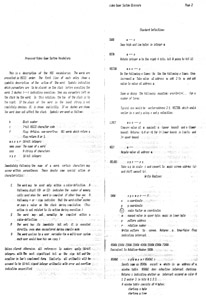 |
Video Game System Glossary. By Unknown. 19xx. From the collection of Jamie Fenton (BitSavers.org). I think that this document has to do with the TERSE programming language. Here is the first paragraph from the Proposed Video Game System vocabulary document: "This is a description of the VGS vocabularies. The words are presented in ASCII order. The first line of each entry shows a symbolic description of the action of the word: symbols indicating which parameters are to be placed on the stack before executing the word, 3 dashes (---), indicating execution, then any parameters left on the stack by the word. In this notation, the top of the stack is to the right. The place of the word in the input string is not completely obvious, is shown explicitly. If no dashes are shown the word does not affect the stack." |
 |
Z-80 Disk Block Organization. 19xx. From the collection of Jamie Fenton (BitSavers.org). This 16-Page document seems to be the op code formats for TERSE assembly. |
